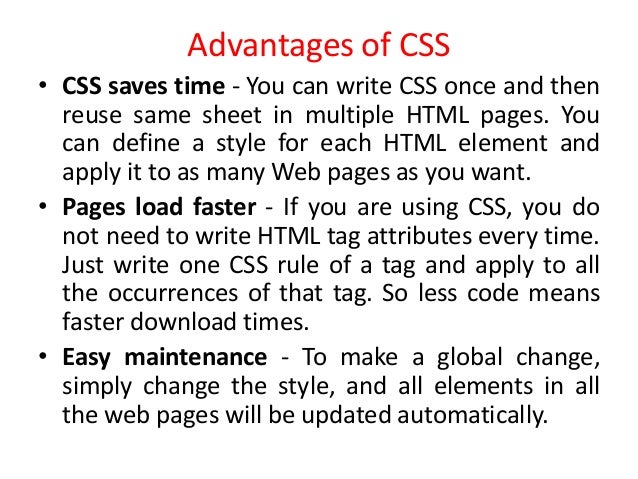Advantages of CSS
- Better Website Speed. For a website to function efficiently, it should have a faster load time. …
- Easier to Maintain. CSS is easy to maintain due to less maintenance time. …
- Consistent Design. …
- Time-Saving. …
- Better Device Compatibility. …
- Positioning of Design Elements.
Ainsi, What does CSS stand for in HTML?
Cascading Style Sheets (CSS) is a stylesheet language used to describe the presentation of a document written in HTML or XML (including XML dialects such as SVG, MathML or XHTML). CSS describes how elements should be rendered on screen, on paper, in speech, or on other media.
De plus, What are the limitations of CSS? CSS has various limitations as a programming language thats are as follows:
- CSS cannot perform any logical operations like if/else or for/while or +/-.
- We can not read any files using CSS.
- It can not interact with databases.
- CSS can not request a web page.
What are the 5 capabilities of CSS? CSS can define color, font, text alignment, size, borders, spacing, layout and many other typographic characteristics, and can do so independently for on-screen and printed views.
Par ailleurs, Is CSS better than HTML? HTML provides tags which are surrounding the content of any web page elements, whereas CSS consists of selectors which are surrounded by a declaration block. CSS has fragmentation, but HTML doesn’t produce any such problems. CSS uses a much lesser code and thus produce much lesser web page loading time than HTML.
Why CSS is called cascading?
The name cascading comes from the specified priority scheme to determine which style rule applies if more than one rule matches a particular element. This cascading priority scheme is predictable. The CSS specifications are maintained by the World Wide Web Consortium (W3C).
Is CSS a language?
CSS is the language for describing the presentation of Web pages, including colors, layout, and fonts. It allows one to adapt the presentation to different types of devices, such as large screens, small screens, or printers. CSS is independent of HTML and can be used with any XML-based markup language.
What is difference between HTML and CSS?
HTML is a markup language used to create static web pages and web applications. CSS is a style sheet language responsible for the presentation of documents written in a markup language.
What is basic CSS?
CSS stands for Cascading Style Sheets. CSS describes how HTML elements are to be displayed on screen, paper, or in other media. CSS saves a lot of work. It can control the layout of multiple web pages all at once.
What are the different types of CSS?
There are three types of CSS which are given below:
- Inline CSS.
- Internal or Embedded CSS.
- External CSS.
How do CSS frameworks work?
With a CSS framework, the user has a completed CSS stylesheet, and they only have to code the HTML with accurate classes, structure, and IDs to set up a web page. The framework already has classes built-in for common website elements – footer, slider, navigation bar, hamburger menu, column-based layouts, etc.
What are the 3 kinds of CSS?
There are three types of CSS which are given below:
- Inline CSS.
- Internal or Embedded CSS.
- External CSS.
What are CSS rules?
A CSS rule is a grouping of one or more CSS properties which are to be applied to one or more target HTML elements. A CSS rule consists of a CSS selector and a set of CSS properties. The CSS selector determines what HTML elements to target with the CSS rule.
Is CSS difficult to learn?
Is CSS easy to learn? It might look messy and confusing, but the fundamentals can be learned very easily. CSS is easy to learn and get started with. However, CSS is unique in that the more you learn and the deeper you go, the more difficult and challenging it becomes.
Can you use CSS without HTML?
yes, you can use css without html: with any document supporting css, such as svg; but alone, css will lacks a target document to be styled… you can use css with html either by inserting css code as <style> tag(s) content, or by linking external file(s) with <link> tag.
What are the three types of CSS?
There are three types of CSS which are given below:
- Inline CSS.
- Internal or Embedded CSS.
- External CSS.
Découvrez plus d’astuces sur Ledigitalpost.fr.
What are the 3 types of CSS?
There are three types of CSS which are given below:
- Inline CSS.
- Internal or Embedded CSS.
- External CSS.
What is Z index in CSS?
The z-index CSS property sets the z-order of a positioned element and its descendants or flex items. Overlapping elements with a larger z-index cover those with a smaller one.
What is a universal selector in CSS?
The Universal Selector is the * in CSS. Literally the asterisk character. It is essentially a type selector that matches any type. Type meaning an HTML tag like <div> , <body> , <button> , or literally any of the others.
Is learning CSS easy?
CSS is an easy programming language to learn at a basic level. The CSS technology was designed to be accessible so anyone could create their own styled web pages on the internet. A lot of the syntax you see in CSS will be very familiar when you learn the basic concepts of HTML.
N’oubliez pas de partager l’article !
